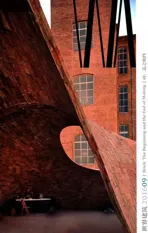再利用奖:马里利亚办公楼,圣保罗,巴西
2016-10-19建筑师超级柠檬工作室
建筑师:超级柠檬工作室
Architects: SuperLimão Studio
再利用奖:马里利亚办公楼,圣保罗,巴西
Category Winner in Re-Use: Marília Project, São Paulo, Brazil, 2013
建筑师:超级柠檬工作室
Architects: SuperLimão Studio
这座建筑坐落于距离圣保罗人大道不远的历史地块。与所在区域内其他的大户住宅相比,它在尺度和比例上显得颇为谦逊,却具有丰富的细部。在它将近百年的历史岁月中,这座老房子已然经历了多次改造。
它是在这个如今满是高楼大厦、玻璃塔楼的街区中一个渺小的幸存者。基于这个原因,我们决定保留这座老房子。为了使原初内部以小隔间划分的老房子适应新的商业用途,我们决定将空间进行整合,生成能够根据客户需求而关闭的大空间,提供高度的灵活性。这种改动带来了很大的结构转变需求,因此我们也给出了设计中需要遵循的清晰逻辑:所有的改造都要将新与旧之间的对比明确地呈现出来。
对空间利用率低下的部分进行拆除,使得重新建造两层空间成为可能。这部分建造遵循了新的建筑退线要求,因而产生了金字塔状的体量分布。这也使得所有的空间拥有了通往宽敞露台的直接联系。
在基础施工时对地下室进行挖掘的过程中,我们发现了许多精美的大型砖结构基础。这部分空间容纳了水电设备和电梯机房的技术区,以及一层新的地下使用层。
由于这座砌体结构的老房子年代久远,我们选择建造一个独立的外骨骼式钢结构体系,以将新的荷载直接传递到在老房子下因循而建的新增建筑基础。依据墙体各自所在位置的具体情况,采取了不同的修复技术,例如锚固式连接外梁。它们起到压缩墙体的作用,防止不牢固的砖块四分五裂而倒塌。这是一种在意大利修复中世纪建筑时广泛应用的技术。
除了重新利用几乎所有现存材料外,所采用的装配式结构也大量减少了碎料的产生,继而减少能源消耗与因运输造成的CO2排放。
建筑原有的大片墙体保证了很高的热惰性,将此特点与交叉通风相结合,便创造出舒适而令人愉悦的室内空间。(陈茜 译)




1 外景/Exterior view2 首层平面/Floor 0 plan3 砖墙/Brick wall4 入口/Entrance5 内景/Interior view6 纵剖面/Longitudinal section
项目信息/Credits and Data
客户/Client: Marcos Salotto
设计团队/Design Team: Lula Gouveia, ThiagoRodrigues,Antonio Carlos Figueira de Mello, Sergio Cabral (SuperLimão Studio)
合作方/Collaborators: JanZiober, Luiz Felipe Saes, Marcelo Rebelo, Luciana Uras
结构支持/Structural Reinforcement: SuperLimão Studio and Ricardo Zulkes
钢结构/Steel Structure: ExataEngenharia
加建结构/Additional Projects: Dlameza Engenharia de Projetos
建造与项目管理/Construction and Management: SuperLimão Studio
混凝土地面/Concrete Floor: Concresteel
木工/Joinery: Marcenaria Baru and MarcenariaImagil
木材修复/Wood Restoration: Guri Restauros
砌块、铺地与木料修复/Masonry, Flooring and Joinery Restoration: Antonio Rosendio Amorim
建筑用途/Building's Purpose: 办公空间/Office space
建筑面积/Usable Floor Area: 450m2
砖材类型/Brick Type: 当地砖材再利用/Re-used bricks from the area
建造周期/Construction Period: 2010.02 – 2013.12
摄影/Photos: Maíra Acayaba
The history of this house, located a few meters from Paulista Avenue. Modest in proportions compared to the big houses in the region however rich in details, it has undergone for several reforms over its almost one century of existence.
A small survivor in the region where today is impregnated of high towers with glass facades. Because we decided to maintain the house to adapt the small-compartmentalized areas of the house to its new commercial purposes, we decided to unify the spaces. Creating large spaces that can be closed according to the client's need, thus giving great flexibility to the space. This changes demanded big structural interventions. Therefore we defined that all the interventions would be explicit to show the contrast between the new and the old.
The demolition of the poorly exploited areas aloud the construction of two floors. These were building respecting the new setbacks, which has created a pyramidal volume. Thus all the spaces have direct access to generous terraces.
During the excavation for the foundations, beautiful foundations made of large bricks were found. This space was tapped as technical area for the electrical and hydraulic installations also the elevator hound house and a new underground floor.
Due to the old age of the house in masonry,it was chosen to create an independent steel structure as an exoskeleton to transfers the new loads direct to the new foundations, which were literally build under the existing house. In cases where the walls were compromised different restoration technics were used, such external beans connecting bolts. They compress the walls and prevent them to collapse like a house of cards. This is a widely used technique in medieval restoration in Italy.
Beyond reuse almost all the existent material,the prefabricated structure reduced dramatically the production of rubble, consequently energetic costs and CO2emission with transportation.
The original large walls guarantee a huge thermal inertia, when it allies with cross ventilation they create a pleasant space.

7 露台/Terrace
评委评语
约翰·阿里:马里利亚办公楼项目在重新利用旧建筑残余部分来创造崭新生活环境的处理上,探寻到了一种出色的解决方式。得益于现存的建筑构造,从头设计所不可能具有的、非同寻常的自由感受诞生出来。设计师珍视现存建筑具有的可能性,这表现在不同侧面:旧建筑具有的热学性能、温暖而质朴的特征,以及经济考量。我想以下可能是我们当今需要面对的最大挑战之一:重新利用我们所拥有的东西,从这里出发,继而去重新创造我们的新世界。令人欣赏的是这个项目对更广泛的周围环境产生影响的方式。砖是作为现有部分被保留下来的,因此他们增加的仅仅是轻质材料。借助这种方式,新与旧的并置以一种自由、美观、充满幽默感的新式样呈现出来。它甚至将周围的巨构塔楼都变得温馨美好起来。(陈茜 译)
Jury Statement
Johan Anrys: The Marília Project has found a beautiful way of reusing the remnants of an old building to create a generous new living environment.Thanks to the existing fabric, extraordinary freedoms were found that would not have been possible when building from scratch. The designers valued the potential of the existing building, its different aspects: the thermal capacity an old building has, its warm and rustic character and the economic aspect. I think this is one of the big challenges that we have to face, the reuse of what we have and, from there, the reinvention of our new world. What is nice is how the project affects even the broader environment. Brick is the existing part that has been kept, so what they added was only light material. This way, the old and new come together in a very free, beautiful new style full of humour. It makes even the huge tower buildings around it warmer and better.
评论
张雷:项目的改造对象是一个始建于1915年的砖砌住宅,在此后的近百年间经历了多次改造,而红砖的砌筑部分在设计者看来是其多重历史记忆的重要载体。历史是过去,也是现在和未来。建筑的时间轴线被设计透明性的视觉要素和组织逻辑有意地展现和延续。由于功能性的需求,游离、镶嵌或是覆盖在砖墙之外新的围护构件,无一例外地采用纯净而透明的工业化形式,包括精心排列的设备管线。新建的部分与砖墙保持清晰的层叠关系,呈现出“过去”与“现在”,“前景”与“背景”在视觉上的辩证关系。透明的时间逻辑,在建筑师的对结构体系的重构过程中,得到更加抽象隐秘的演绎。成为沉重主体的钢构架,在视觉上却让位于保留的砖砌部分。
Comments
ZHANG Lei: The renovation object of the project was a brick house built in 1915. In the next 100 years or so,it underwent several transformations. The red brick masonry of the building, in designerss eyes, appeared to be an important carrier of the multiple historic memories about it. History might be the past, the present or even the future. The timeline of architecture is designed to be transparent in accordance with visual elements and organizational logic, with intentional exhibition and continuity. Owing to functional requirements, the dissociated,embedded or covered enveloping components on the external part of the brick wall, unexceptionally,are designed in pure and transparent industrial form,including carefully-arranged equipment pipelines. The overlaps between the newly built part and the brick wall are maintained to show the dialectical visual relationship between "the past" and "the present", as well as "the foreground" and "the background". In restructuring the building, the architects obtained a deduced time logic of transparency in a more abstract and secret way. The result is a heavy steel-framed volume, visually giving way to remained masonry part.
朵宁:这个案例是一个旧建筑再利用塑造新型空间结构的范例。设计者在原有砖墙和新建结构之间建立了清晰的关系,而两者交错造成的空间多样性也令人赞叹。最为人称道的是,项目的完成外观具有一种城市风貌的自发性:分离的结构、逐层的退台和外置的设备赋予了这个办公建筑一种业主自主建设的无秩序感。这种貌似野生的活力和精密推敲的控制形成对比,最终达到一种富于张力的平衡感。
DUO Ning: The case is an exemplar that recycles an old building to form a new type of spatial structure. The designer has established a clear relationship between the original brick walls and the new structure,the intersection of which has created the impressive spatial diversity. The most remarkable point lies in the completed appearance of the project as a spontaneous urban scene, i.e. a separate structure, cascaded terrains and external equipments provide the office building with a sense of disorder for the owner to independently build. Such seemingly wild vitality, in a contrast with the precision of control, has ultimately achieved a sense of balance full of tension.

8 内景/Interior view 9 相互交织的新旧材料/Old and new materials joining together
